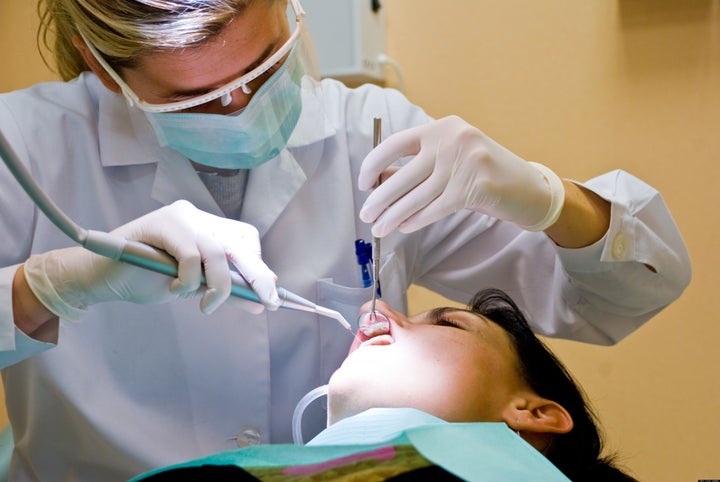
Let's talk about dental crowns today, because it's my opinion that they are generally a misunderstood (and disliked) dental procedure. Misunderstood because most dentists do not explain crowns very well, and disliked because they are costly, and insurance companies typically do not cover more than 50 percent of the cost. For this article, we'll use the term "crown," but can also mean "cap" (as crowns were commonly called years ago).
What Is a Dental Crown?
A dental crown is, for lack of a better term, a permanent covering for a tooth. They can vary in construction material from all metal to porcelain fused to metal, all resin, or all porcelain/ceramic. They all have their advantages and drawbacks. All metal crowns are the strongest and longest lasting, but don't have the most attractive appearance (although some people opt for gold). Porcelain fused to metal is a popular choice, because they generally look good, and are strong as well. The only drawback to them is sometimes, you can see the metal right along the bottom of them. All Porcelain/All Ceramic also look really nice, but aren't as strong as porcelain fused to metal. Still, many people think they look the best for front teeth. All-resin crowns are the cheapest option, but they are also the weakest -- I do not recommend them.
The above dental crowns are almost always fabricated outside the dentist's office. This is where the extreme costs come in; indeed, it is a small item in stature, but a quality crown is made to fit your exact bite, and is handcrafted by a skilled professional. And even with a porcelain covered metal crown, the alloy under the porcelain is a quality metal -- Platinum/Palladium/Gold.
There are machine-made crowns, which are cheaper in price, but again, I'm not really a fan of them. They look fake, but the biggest problem is they don't fit very well. In my opinion, "good enough" is not an option when it comes to crown fit. Food and bacteria will get trapped, and defeat the purpose of having a crown in the first place.
Also contributing to the cost is the fact that a crown is a two-visit procedure: first, an impression must be made (so the crown will fit), and at this time, the tooth is prepared for the crown (sometimes with a post, sometimes by just shaping the tooth, and sometimes both. It all depends on how much "good" tooth there is to work with.) After tooth prep, a temporary crown is fitted to keep the tooth clean. Then, when the crown is finished, the patient returns, and the "temp" is replaced with the real crown, which is cemented in.
What are Dental Crowns Used for?
While the reason to get a crown can be cosmetic in nature (in fact, as a NYC Cosmetic Dentist, I see this more often than some other dentists who don't do cosmetic work), for most folks, a dental crown is generally a "save the tooth" procedure.
This is where the misunderstandings I mentioned above come into play. Indeed, there are plenty of instances where the need for a crown is evident (like a broken tooth), but oftentimes, the "need" for a dental crown is not apparent to the patient. Here are some "but it's not broken" instances that call for a dental crown:
- To strengthen a tooth that has/had a very large (and usually old) filling.
- To repair a tooth that has a very large cavity.
- To anchor a bridge.
- To protect a tooth that had a root canal.
In many of these instances, the "need" for the crown is not overly obvious. For example, we're used to getting fillings for cavities. But for very large cavities, fillings are usually not a good solution, as the larger the filling, the less tooth there is, and the greater chance that the filling will fall out (or the tooth will just crack). As a dentist, if I know a patient's tooth has a good chance of breaking, I feel it is irresponsible of me to let them leave my chair without telling them all of their options.
And trust me, there is a point where a filling is just going to be too big -- at that juncture, it's a crown, or another dentist (obviously, I prefer the second option is not taken, but again, there's a point where I am not going to do a filling I know won't last a reasonable amount of time.)
The problem comes in how does a dentist explain the above without it seeming like a money grab? Especially since there are other dentists out there who will happily do an overly large filling, despite the fact they know the tooth will likely soon break (which is not in the patient's best health interest). Of course, on the other side of that coin, there are also dentists that want to crown every tooth in sight, which, to me, is just as unscrupulous.
For me, the answer is trust. I work hard to build trust with my patients, and I try to present them with every option available to them, along with the pros and cons of each. I realize finances play a role in most dental decisions, but I make sure that it's the patient's finances that direct things, not mine. I feel it's in my patient's best interest (and mine, as a business professional) that I clearly explain the how and why of my recommendations, and they understand why I reach the conclusions that I do. Like I mentioned above, I won't do a filling I know won't work, and I also won't do an unnecessary crown. My patients know this.
Trust is important. If you trust your dentist, then you are likely in good hands. If you do not, it's time for a new dentist.
Until next time, keep smiling.